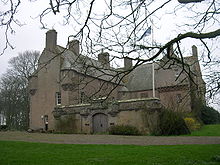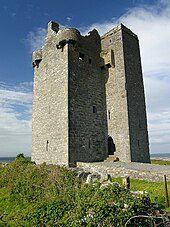L-plan architecture
As L-plan castle are castles and residential towers in the shape of an L , typical of the 13th, referred to 17th century. This construction is quite common in Scotland , but also in England , Ireland, Romania , Sardinia and other regions. The L-Plan emerged as an extension of the block house or a simple square tower in the early Middle Ages . As construction techniques improved, it became possible to build a larger foundation and a more complex shape. One motivation for the L-Plan was the associated possibility of defending the entrance door from the adjacent walls by means of fire protection. This trick was particularly promoted by the advent of cannons used by the attackers.
It was customary to use very thick walls to connect the two wings. For example, the stone walls of Muchalls Castle in Scotland are over fourteen feet thick at the bottom. The ramparts, built in the 13th century, support a defensive tower . A reconstruction from the 17th century probably consisted of a structure of the same size.
Other examples of the Scottish L-plan castles include:
- Culzean Castle , built in Ayrshire in the late 16th century
- Dalhousie Castle , built in the 15th century as a residential tower near Dalkeith in Lothian
- Dunnottar Castle , a partially destroyed castle on a cliff on the North Sea near Stonehaven
- Erchless Castle , a 14th century Norman castle in Invernessshire
- Fernie Castle in the 16th century in Fife built
- Neidpath Castle , built by Clan Fraser at Peebles in the 13th century
Examples of Irish L-plan architecture are Balingarry Castle in Balingarry, which was originally built as a pre-Norman ring castle but was converted into a high medieval L-plan residential tower, and Gleninagh Castle from the 16th century, which is only partially preserved. The L-Plan also served as a template for Rathmore Castle in County Meath.
The Herasti Castle in Ilmov in Romania, which includes parts of the Italian Renaissance , is an example of Eastern Europe . In Cagliari, Sardinia, two remaining L-plan style buildings are known as the Pisan Towers; a third was destroyed by the English and Spanish navies. The buildings date from 1217 and are each 30 meters high. They served as important watchtowers over the sea and the island's interior.
literature
- Nigel Tranter: The History of the Fortified House in Scotland . Six volumes, Oliver and Boyd, 1962-1971.

